Health
Goat Cheese And Caramelized Onion Pizza

This goat cheese and caramelized onion pizza is my favorite restaurant-quality meal I make at home! I love how easy this recipe is to make. The crispy crust paired with creamy goat cheese and sweet caramelized onions is a match made in heaven! My recipe is perfect for a healthier family-friendly pizza night that’s better than takeout, and more budget-friendly too.

If you know me, you know I love pizza. I’ll make it in all sorts of ways – from a quick pizza on naan bread, to stuffing the ingredients into zucchini boats, or combining the ingredients into a keto pizza bowl! No matter how I serve it up, I’ve found it’s impossible to go wrong with pizza and all the delicious toppings available.
And the first time I had a goat cheese pizza with caramelized onions, I knew I had to find a way to recreate it at home. My recipe brings together the sweetness of the onions and the tang of the goat cheese for a mouthwatering flavor combination!
When it comes to shaking up the regular pizza night rotation, I always start by experimenting with different cheeses. If that’s your jam too, I highly recommend trying my pear gorgonzola pizza after you make this recipe!
My goat cheese caramelized onion pizza recipe is gourmet without the complicated cooking process, which is perfect for elevating weeknight meals.
The crust is thin and crispy, adding a nice texture to the softer ingredients on top. The tangy goat cheese and sweet onions pair nicely with the crisp pizza crust, and the fresh thyme gives this pizza a hint of herbal richness. It’s way better than pizza delivery and healthier too!
I made a few swaps to increase the nutrition while reducing calories and fat and without losing any of the flavor, so this pizza leans to the healthier side of the usual fast food version.
Surprisingly, my kids also love this goat cheese pizza recipe. While this pizza is not the traditional kind they’re used to, they enjoy the cheesiness, along with the sweetness of the onions. Plus, when the kids aren’t around, I love to make this for a date night in! Either way, I’ve got dinner on the table in about an hour.
Latest Recipe Video!
🥘 Ingredients
I love a gourmet meal without a long list of ingredients! In fact, many of these ingredients I always have on hand in the pantry. Here’s what you need:

Whole Wheat Flour: My homemade dough starts with a combination of warm water, dried yeast, and a touch of honey. I use whole wheat flour or white whole wheat flour to add fiber which is important for healthy digestion, regulates blood sugar, and lowers cholesterol (source). Plus, it creates a more nutrient-dense dough.
Olive Oil And Salt: I add a touch of olive oil and salt to finish off the dough to make it easier to roll out.
Caramelized Onions: I use two thinly sliced red onions cooked down with a little olive oil, coconut sugar, and balsamic vinegar to create that tangy, caramelized finish. I use minimal sugar in this recipe to keep it low in sugar.
Goat Cheese: I love the tang of this cheese! It is unmatched! While it won’t melt completely like mozzarella, it will soften and is much creamier than mozzarella. Goat cheese is naturally lower in fat and calories than cheese made from cow’s milk.
Thyme: I use thyme to add a little herby flavor to the pizza.
🔪 How To Make Caramelized Onion Goat Cheese Pizza
Prepare Yeast For Dough: I start by mixing the water, honey, and yeast in a small mixing bowl, stir, and set aside for 10 minutes to allow the yeast to start to foam.
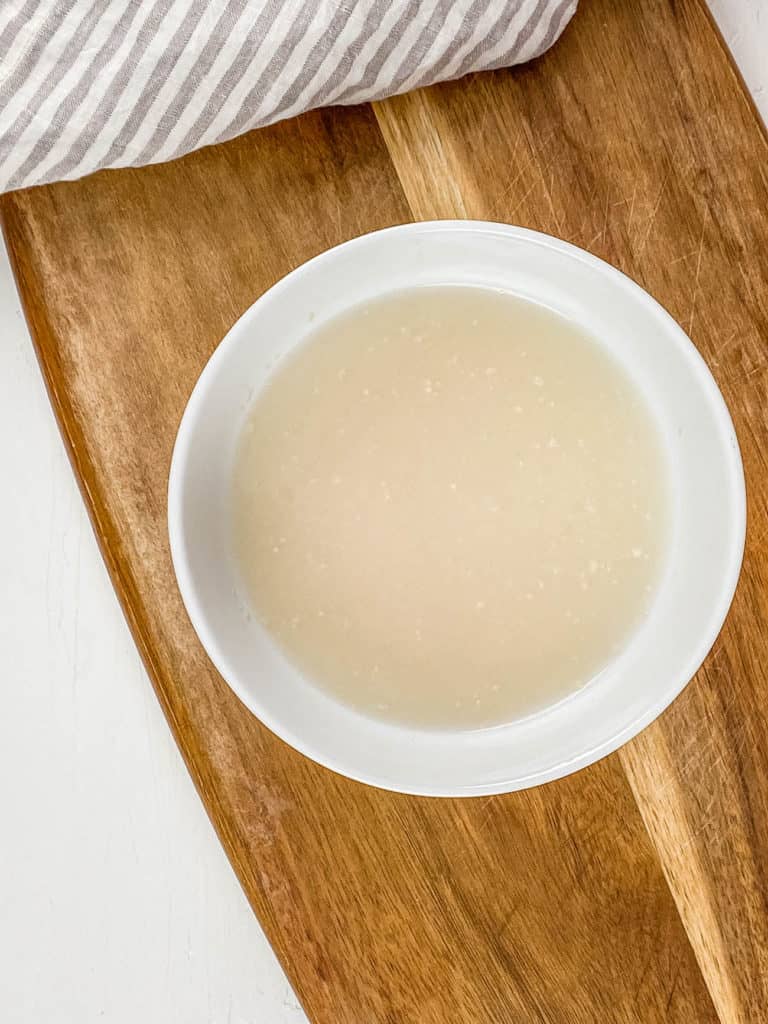
Whisk Flour: Next, I whisk together the flour and salt in a large bowl.
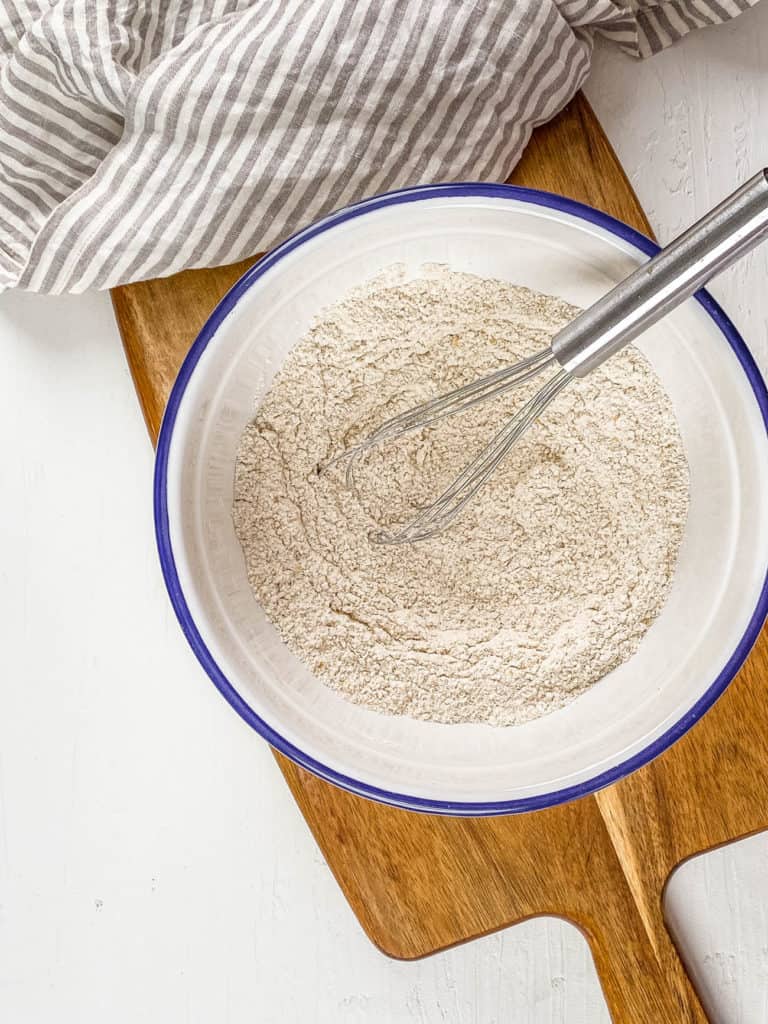
Form Dough: When the yeast mixture starts to foam, I pour it into the flour mixture along with the oil, and stir to form a dough.
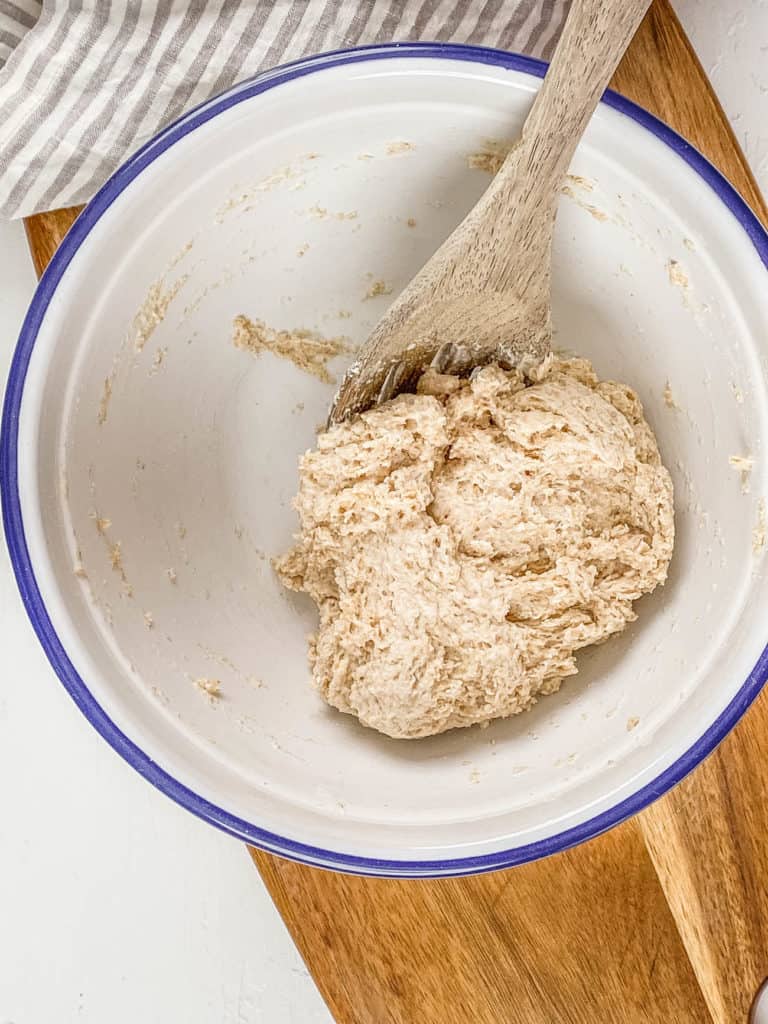
Knead Dough And Allow To Rest: Next, I turn the dough out onto a floured surface and knead with the heels of my hands for 2-3 minutes, shaping into a ball. Then, I return the ball of dough to the mixing bowl, cover and rest for 30-45 minutes to allow it to double in size.
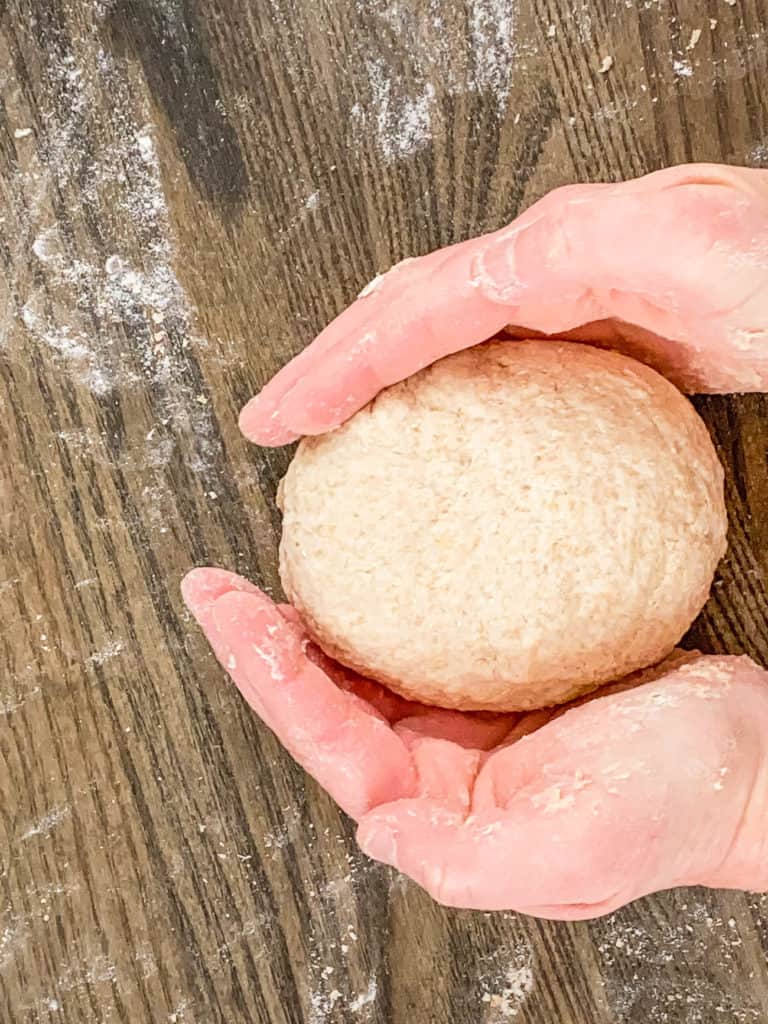
Prepare Caramelized Onions: While the dough is resting, I prepare the caramelized onions. I start by heating the oil in a large skillet over medium-high heat and add the red onion slices. I sauté the sliced onions for 2-3 minutes then I reduce the heat and continue to stir as they cook for 10 minutes. Sometimes, I’ll add a little water to stop them from sticking to the bottom of the skillet. Then, I add the coconut sugar and balsamic vinegar and stir them through.
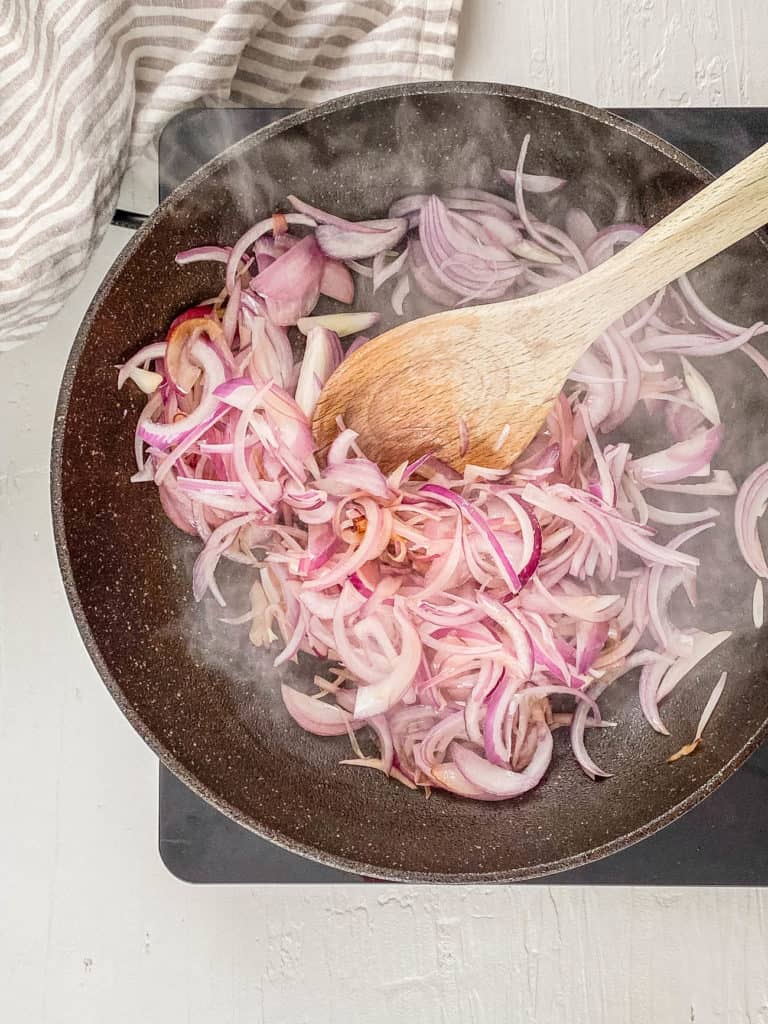
Remove From Heat: When the onions have completely caramelized, I remove them from the heat, season with salt, and set aside to cool.
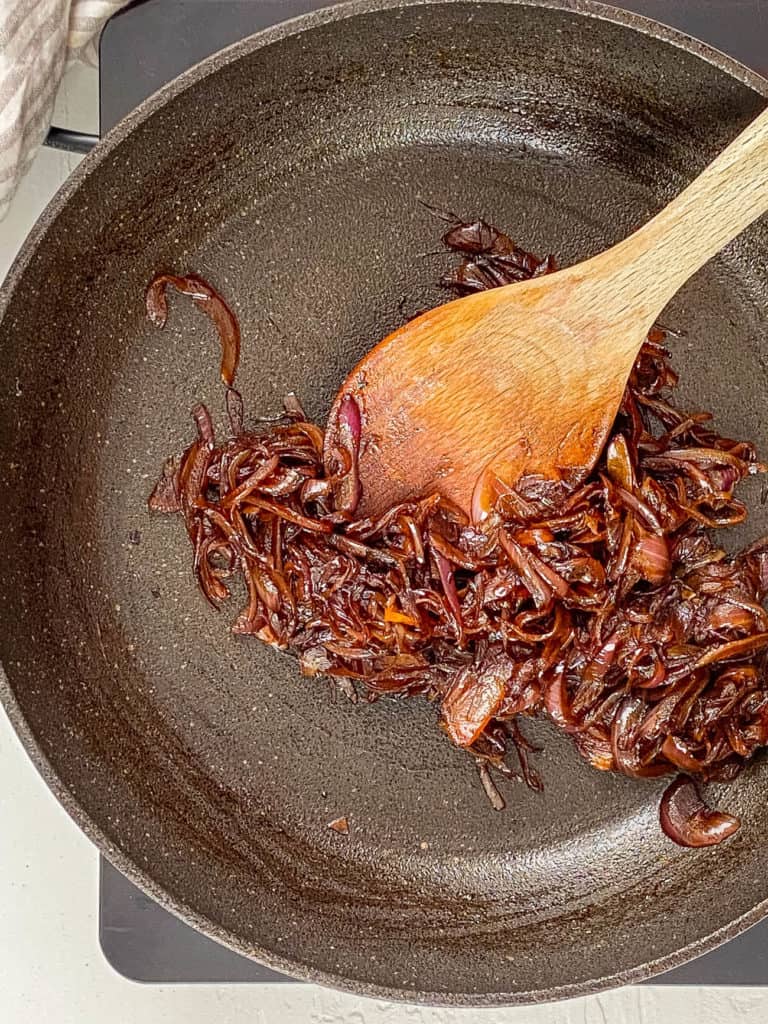
Preheat Oven: Before assembling the pizza, I’ll preheat my oven to 390 degrees Fahrenheit. If I’m using a pizza stone, I’ll place it into the oven to preheat as well.
Assemble: While the oven preheats, I’ll assemble my caramelized onion and goat cheese pizza. After the dough has doubled in size, I’ll remove it from the bowl and spread the dough into a 12 inch round on a tray lined with baking paper, or I’ll divide the dough and roll into 2 smaller pizzas.
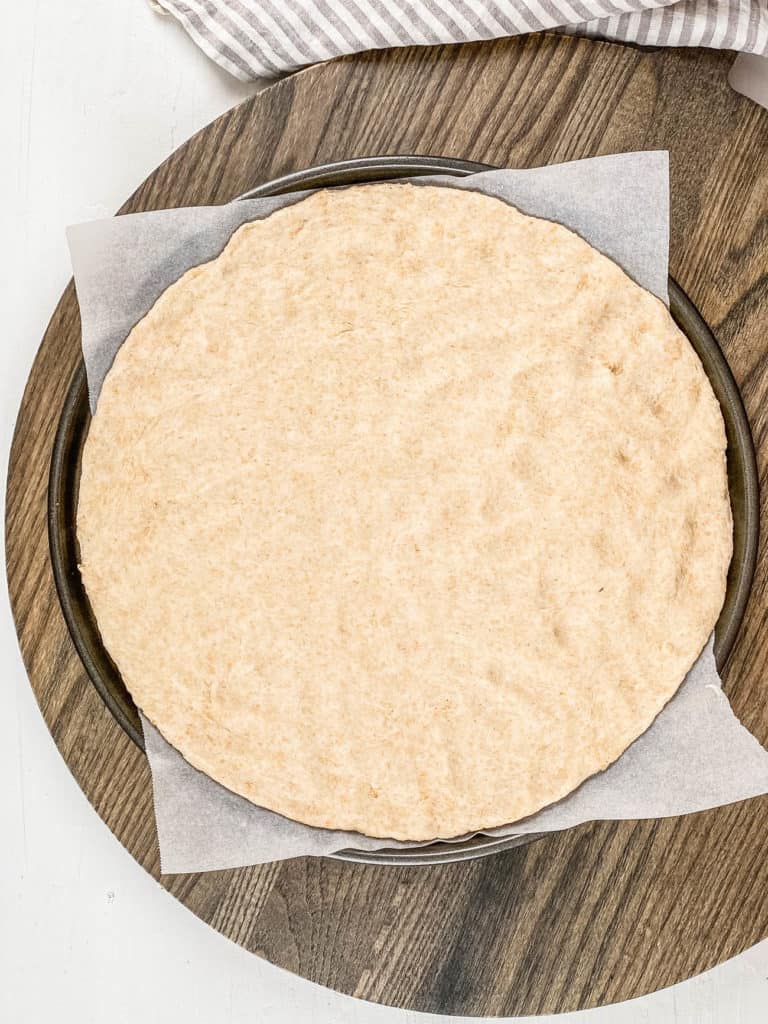
Add Toppings: Then I top the pizza dough with the caramelized onion, crumbled goat cheese, and fresh thyme, leaving a 1-inch border around the edges.
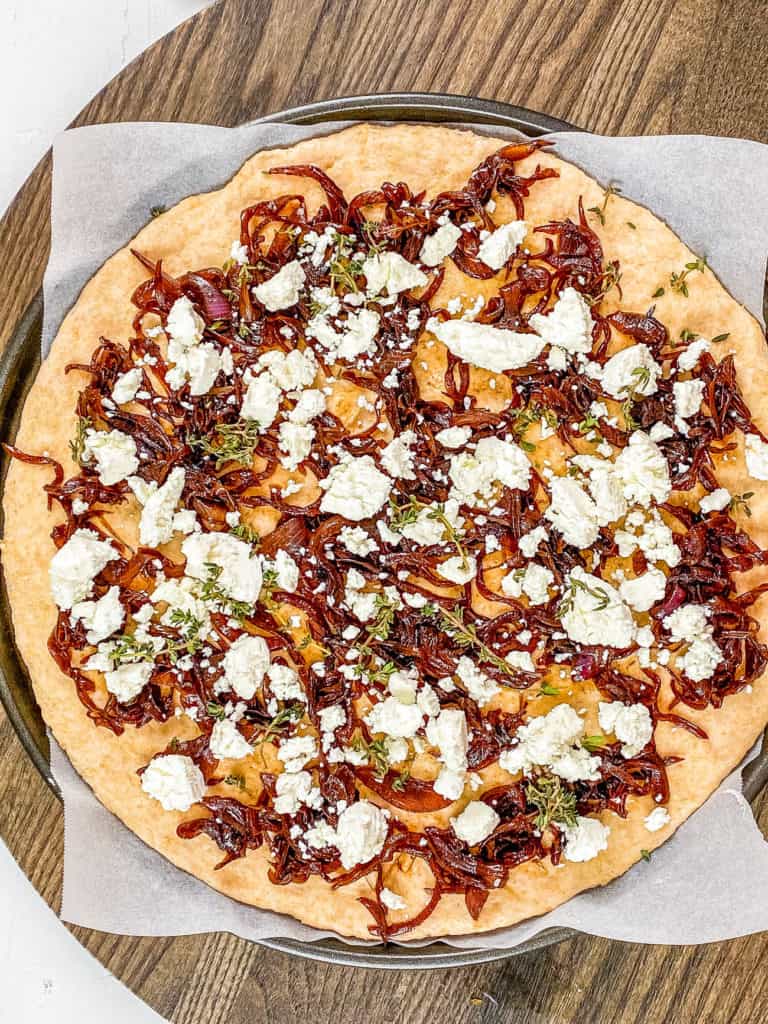
Bake Pizza: If I’m using a pizza stone, I’ll transfer the prepared pizza onto the pizza stone or cook the pizza as it is on a large baking sheet for 15-20 mins or until golden brown. Then, I’ll cut it into 8 equal pieces to serve!
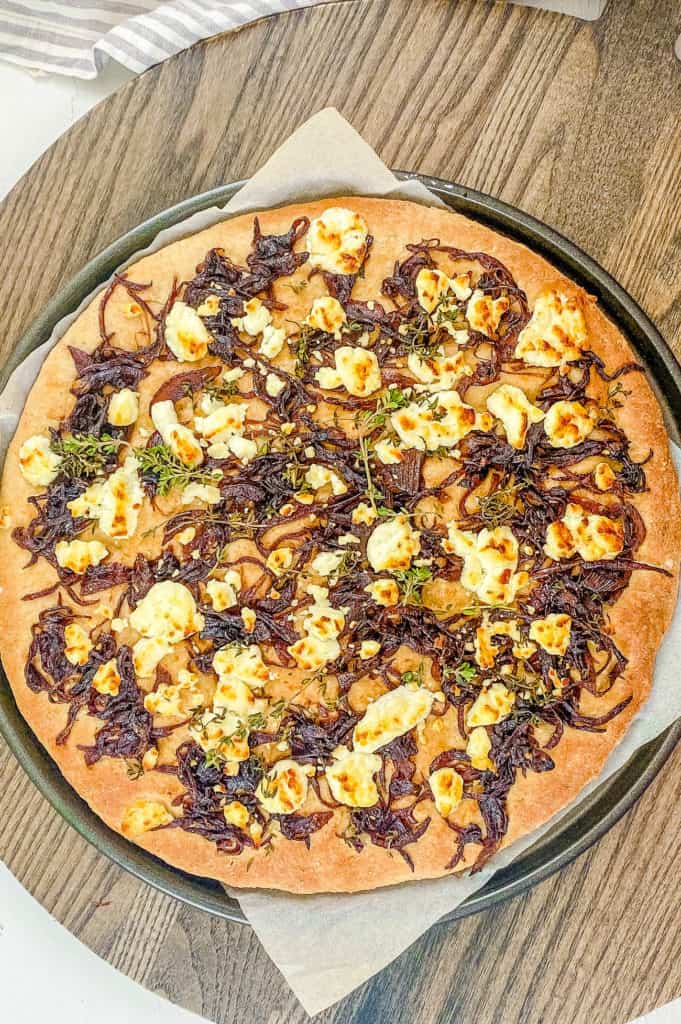
My #1 Secret Tip for this making pizza with caramelized onions and goat cheese centers around the dough. I know that homemade pizza dough can be intimidating if you’re a newer cook, but I promise, I’ve created this recipe to make it as easy as possible.
For the dough: when activating the yeast, always make sure the water is warm – never hot! Otherwise, the yeast will not activate.
Make sure to knead the dough until it just springs back when you press gently on it, and after the dough has been kneaded, I cover it and leave it in a warm place to double in size. Usually, this place is a countertop at room temperature or even inside of a cooled oven.
And if you can, invest in a pizza stone! A preheated pizza stone helps transfer heat evenly to the crust, resulting in a perfectly cooked and crispy base for your pizza.
Other Tips To Keep In Mind:
- Cook The Onions Low And Slow: I always caramelize onions over medium-low heat, stirring occasionally. This allows the sugars to slowly release and brown beautifully, resulting in a deep, sweet flavor.
- Embrace The Maillard Reaction: Don’t stir the onions constantly once they start to brown. I try to let them sit undisturbed for short periods to develop those delicious caramelized bits on the bottom of the pan, and just gently nudge them around to prevent burning.
- Topping Quantity Matters: While tempting, resist the urge to pile on too many toppings. This can weigh down the crust and make it difficult to cook through. I like to sprinkle the toppings over the crust until it’s just lightly covered.
- Change Up The Texture: Sometimes, I’m in the mood for a softer or crunchier onion. This means I’ll cook them longer for a softer texture or shorter for a crunchy bite! The texture is according to preference.
📖 Variations
Flavored Cheese: Goat cheese comes in different flavor varieties. Sometimes, I’ll use garlic and chive flavored goat cheese or another flavor to add more punch.
Additional Cheese: For a cheesier pizza, I like to add mozzarella cheese, fontina cheese, or parmesan cheese.
Additional Toppings: There are so many different toppings that go with goat cheese on pizza! For variety, I’ll add diced fresh figs, arugula, a drizzle of balsamic glaze, or some red pepper flakes for a little spice. Instead of thyme, I’ll also use fresh rosemary, lemon zest, or fresh basil. I also like adding diced red peppers, kalamata olives or sundried tomatoes!
Add Protein: If you don’t need this pizza to be vegetarian, you can top with thinly sliced pieces of chicken breast or prosciutto, or for a veggie protein option, add some pine nuts or walnuts.
Pizza Crust: If I’m short on time, I’ll use a store-bought pizza crust instead of making the pizza dough from scratch.
Add A Sauce: This healthy pizza recipe doesn’t have an added sauce, but if you like a sauce on your pizza you can add regular pizza sauce, a pesto sauce, garlic sauce, or a white sauce.
🍽 Serving Suggestions
For a complete meal, I pair this pizza with goat cheese and caramelized onions with a light salad or soup.
Salads: I serve this pizza with a keto Greek salad for some extra veggies or my apple walnut salad with a little extra protein from the nuts. My Greek farro salad or roasted pumpkin salad would be great for the Fall season.
Soups: In the cooler months, or for a heartier meal, I like to serve this pizza with my creamy asparagus soup with goat cheese, mushroom soup without cream, or Greek lentil soup.
🧊 Storage Directions
When I have leftovers, I always allow the pizza slices to cool completely and make sure to wrap each slice well with plastic wrap.
Fridge: I store this pizza in the refrigerator for up to 3 days. I wrap each of the slices in plastic wrap or aluminum foil, or transfer to an airtight container.
Make Ahead: I make pizza dough ahead of time and store it, covered in the fridge for several hours. Then, I allow it to come to room temperature before spreading on to the pizza stone or baking sheet and assembling.
Freezer: To freeze the pizza dough, I wrap the ball of dough with plastic wrap and place in a zip-top bag and freeze for up to 3 months. When pizza night comes around, I defrost in the fridge and allow it to come to room temperature before rolling it out.
Reheating: To reheat individual slices, I preheat the oven to 350 degrees Fahrenheit, and place pizza on a baking sheet. I bake for about 5-8 minutes, until warm in the center and the crust begins to crisp up.
❓Recipe FAQs
Not completely. When goat cheese is heated it softens, but it does not melt the same way mozzarella does. Whereas mozzarella gets gooey and stringy, goat cheese when warmed becomes creamier but does not get that stretchy cheesy texture.
I use plenty of flour on my hands and the work surface to prevent sticking. I also let the dough come to room temperature before stretching it to make it more pliable. Don’t be afraid to use a rolling pin if stretching by hand is too difficult.
Sometimes, when I overload my pizza with too much of the toppings, it prevents the pizza from cooking thoroughly. While it’s easy to get carried away, I try to keep the toppings as close to the measurements as possible. Also, using a pizza stone helps evenly distribute the heat along the bottom of the pizza. If you’re still having trouble with a soggy crust after trying these tips, I recommend pre-baking the crust for a few minutes before adding your toppings and that should solve the issue.

Want to Save This Recipe?
Enter your email & I’ll send it to your inbox. Plus, get great new recipes from me every week!
By submitting this form, you consent to receive emails from The Picky Eater.
Love this healthy pizza recipe? Please leave a 5-star rating 🌟 in the recipe below and/or a review in the comment section further down the page!
You can also FOLLOW ME on FACEBOOK, INSTAGRAM, and PINTEREST to see more delicious, healthy, family-friendly food, and if you have any questions, I’m here to help!
📋 Recipe Card
Goat Cheese And Caramelized Onion Pizza
This goat cheese and caramelized onion pizza is my favorite restaurant-quality meal I make at home! I love how easy this recipe is to make. The crispy crust paired with creamy goat cheese and sweet caramelized onions is a match made in heaven! My recipe is perfect for a healthier family-friendly pizza night that’s better than takeout, and more budget-friendly too.
Servings: 8 servings
Calories: 171kcal
Shop Ingredients on JupiterPrepare Caramelized Onions
- Make sure the water is warm and not hot otherwise the yeast won’t activate.
- Ensure the dough is left in a warm place to rise.
- Pizza dough can be prepared ahead of time and stored, covered in the fridge. Allow it to come to room temperature before using.
- Pizza bases can be cooked and frozen for up to 3 months.
Serving: 1slice | Calories: 171kcal | Carbohydrates: 23g | Protein: 6g | Fat: 7g | Saturated Fat: 2g | Polyunsaturated Fat: 1g | Monounsaturated Fat: 3g | Cholesterol: 6mg | Sodium: 201mg | Potassium: 142mg | Fiber: 3g | Sugar: 4g
Source link
Health
Is It Safe to Exercise in Extreme Heat and Smoky Skies?



By Brett Goldhawk
UBC professor Dr. Michael Koehle explains why it’s important to adapt your exercise routine to the weather conditions
For many people, summer is an opportunity to bring their exercise routine out of the gym and into the great outdoors.
But as heat waves, wildfires and smoke-choked skies become commonplace for more communities, it’s important to safely adjust your outdoor exercise to the new realities of climate change.
Dr. Michael Koehle, a professor of sport and exercise medicine at the UBC faculty of medicine, discusses how to tell if it’s safe to exercise outside and what to do when conditions become extreme.
What are the health risks of exercising in extreme heat or forest fire smoke?
Exercising in hot conditions can put us at risk of exertional heat illnesses, including heat exhaustion at the mild end of the spectrum, or the more severe variant, heatstroke, which can be life-threatening.
By contrast, living in areas affected by wildfire smoke—whether we’re resting or exercising—exposes us to long periods of very high levels of particulate matter in the air. This can lead to long-term consequences such as heart and lung disease, as well as diabetes and dementia. The harmful effects of air pollution may be compounded during exercise, because the rate and depth of our breathing increases.
Some people are more at risk than others, and this includes older adults, pregnant people, young children, and people with pre-existing health concerns like lung or heart conditions, cancer, diabetes and mental illness.
How do you know if it’s safe to exercise outdoors?
In Canada, we have helpful tools that give us an indication of the environmental conditions outdoors. For temperature, it’s important to consider the humidex, since we have more difficulty managing our body temperature on hot days that are also humid. People will experience discomfort with a humidex above 30 and should be particularly careful with a humidex above 40.
For air pollution, in Canada we use a scale called the Air Quality Health Index (AQHI), which gives an estimate of the air quality health risk on a one-to-10 scale, and can be checked on apps like Plume Labs and AQHI Canada. Environment Canada has reasonable guidance on when it is safe to exercise, but generally speaking, people should consider modifying outdoor activities when the AQHI is above four for at-risk populations, seven for the general population, or if you experience symptoms such as coughing or throat irritation.
What precautions can people take to stay safe when exercising outdoors in these conditions?
The most important strategy is to monitor current conditions and forecasts for both weather and air quality. This allows us to choose the better times of day and locations for physical activity and exercise. Often early morning can be lower-risk for both heat and smoke, and locations like parks that benefit from optimal wind, shade and distance from smoke sources can lead to lower heat and air quality risk.
For more detailed guidance, the Canadian Academy of Sport and Exercise Medicine has helpful recommendations on exercising in air pollution. The Government of Canada also has information and advice for heat and humidity.
Why is it important to continue exercising, even during environmental extremes?
We know that in the long term, a physically active lifestyle is important in preventing and treating many chronic diseases, including those that make people more susceptible to the effects of extreme heat and smoke, so avoiding activity altogether is not a solution.
Instead, using strategies like exercising in the early morning or indoors depending on the weather conditions, can help us to stay active, even when the AQHI or humidex are particularly high.
Although we can acclimate somewhat to high heat and humidity over a period of days to weeks, there is no indication that we can acclimate to the air pollution that comes from wildfires. So repeated exposure to wildfire smoke—during rest and exercise—only leads to increased risk of long-term health consequences. Everyone needs to assess the conditions and adapt our activities accordingly.
Interview language(s): English
Featured Researcher
Professor, Department of Family Practice, Division of Sport & Exercise Medicine
—
Previously Published on ubc.ca with Creative Commons License
***
Join The Good Men Project as a Premium Member today.
All Premium Members get to view The Good Men Project with NO ADS.
A $50 annual membership gives you an all access pass. You can be a part of every call, group, class and community.
A $25 annual membership gives you access to one class, one Social Interest group and our online communities.
A $12 annual membership gives you access to our Friday calls with the publisher, our online community.
Register New Account
Need more info? A complete list of benefits is here.
—
Photo Credit: iStock
Health
Before Michigan Legalized Surrogacy, Families Found Ways Around the Ban



By Kate Wells, Michigan Public
The first time Tammy and Jordan Myers held their twins, the premature babies were so fragile that their tiny faces were mostly covered by oxygen masks and tubing. Their little hands rested gently on Tammy’s chest as the machines keeping them alive in a neonatal intensive care unit in Grand Rapids, Michigan, beeped and hummed around them.
It was an incredible moment, but also a terrifying one. A court had just denied the Myers’ parental rights to the twins, who were born via surrogate using embryos made from Jordan’s sperm and Tammy’s eggs. (Tammy’s eggs had been frozen before she underwent treatment for breast cancer.)
“In the early hours of their lives, we had no lifesaving medical decision-making power for their care,” Tammy Myers told lawmakers at a Michigan Senate committee hearing in March.
Instead, the state’s surrogacy restrictions required the Myers to legally adopt their biological twins, Eames and Ellison.
“Despite finally being granted legal parenthood of our twins almost two years after they were born, our wounds from this situation remain raw, casting a long shadow over the cherished memories that we missed,” Myers told lawmakers, her voice catching.
Until this spring, Michigan was the only state that had a broad criminal ban on surrogacy. Many families say that ban left them in legal limbo: They were compelled to leave the state to have children; find strangers on Facebook who would carry their child; or, like the Myers, be forced to legally adopt their own biological children.
Gov. Gretchen Whitmer of Michigan signed legislation in April repealing the 1988 criminal ban, legalizing surrogacy contracts and compensated surrogacy after more than three decades. But the legalization is raising fears among conservatives and religious groups, who echo Pope Francis’ concerns that surrogacy exploits women and makes children “the basis of a commercial contract.”
As reproductive technology advanced in recent decades, most states passed laws permitting and regulating surrogacy. But Michigan did not, said Courtney Joslin, a professor at the University of California-Davis School of Law who specializes in family law. Still, those restrictions didn’t prevent Michiganders from having children via surrogacy.
“Criminal bans, or even civil bans, don’t end the practice,” Joslin said. “People are still engaged in surrogacy, and it’s becoming more clear that the effect of a ban is just to leave the parties without any protection. And that includes the person acting as a surrogate.”
In 2009, a couple in western Michigan had to surrender custody of twins after their surrogate decided to keep the babies. The surrogate claimed that she hadn’t been aware of an arrest and a mental health issue in the intended mother’s past. In 2013, a surrogate from Connecticut fled to Michigan to give birth, knowing state law would give her parental rights. She and the intended parents had disagreed over whether to terminate the pregnancy following the discovery of major fetal abnormalities.
The Myers family, however, thought they would be able to avoid any protracted legal fights. They had the full support of their surrogate, Lauren Vermilye, a stranger who’d volunteered to be their surrogate after seeing Tammy’s posts on Facebook. Yet even with Vermilye and her husband, Jonathan, saying that the twins belonged to the Myers, Michigan judges denied the Myers’ request for a prebirth order giving them parental rights.
“As a devoted family already raising our kind, inclusive and gentle-hearted 8-year-old daughter, Corryn, we were forced to prove our worthiness through invasive psychological testing, home visits, and endless meetings to discuss our parenting plan to prove that we were fit to raise our twins, Eames and Ellison,” Tammy Myers told lawmakers in March.
Opponents of Michigan’s repeal of its surrogacy ban distinguish altruistic surrogacy — in which the surrogate mother does not receive any compensation, including for her medical and legal expenses — from a contract for a child.
Legislators in Michigan’s House of Representatives passed bills late last year to allow courts to recognize and enforce surrogacy contracts. These bills allowed parents to compensate surrogates, including for medical and legal expenses. But as the legislation moved forward early this year, religious and conservative groups, and some Republican lawmakers, continued voicing their opposition.
Michigan’s surrogacy laws were not preventing altruistic surrogacy in the state, argued Genevieve Marnon, the legislative director of Right to Life of Michigan, at a state Senate committee hearing in March.
“However, current law does require a legal adoption of a child who is born of one woman and then given to another person,” Marnon said. “That practice is child-protective, to prevent the buying and selling of children, and to ensure children are going to a safe home.”
Michigan’s ban on surrogacy is “in keeping with much of the rest of the world,” Marnon said in March. Several European countries ban or restrict surrogacy, including Italy, which is cracking down on international surrogacy, an arrangement involving a surrogate mother who lives in a different country than the biological parents.
“India, Thailand, and Cambodia had laws similar to those contemplated in these bills, but due to exploitation of their women caused by surrogacy tourism, they changed their laws to stop that,” Marnon told the senators in March.
In January, Pope Francis called for a universal ban on surrogacy, “which represents a grave violation of the dignity of the woman and the child, based on the exploitation of situations of the mother’s material needs,” he said.
Rebecca Mastee, a policy advocate with the Michigan Catholic Conference, told lawmakers that while she acknowledged the suffering of people with infertility, surrogacy can exploit women and treat babies like commodities.
“At the core of such agreements is a contract for a human being,” she said.
“That made my blood boil, hearing that,” said Eric Portenga. He and his husband, Kevin O’Neill, had traveled from their home in Ann Arbor to the Capitol in Lansing to attend the hearings in March.
If you’ve been through the surrogacy process “you know there’s no commodification at all,” Portenga said. “You want a family because you have love to give. And you want to build the love that you have, with your family.”
When Portenga and O’Neill were trying to become fathers, they reached out to surrogacy agencies in other states but were told the process would cost $200,000. “We would have had to have sold the house,” O’Neill said.
Like the Myers, the couple turned to Facebook and social media, “just putting our story out there that we wanted to become dads,” O’Neill said. A friend of a friend, Maureen Farris, reached out to the couple: She’d been wanting to help a family through surrogacy for years, she said. And Farris lived just a few hours south in Ohio, where surrogacy contracts and compensation are legal.
Farris’ contract with Portenga and O’Neill was fairly standard. Both sides had to undergo psychological background checks and have legal representation. The contract also set compensation for Farris, which covered medical and legal fees. The contract stipulated Farris couldn’t travel to Michigan beyond a certain point in her pregnancy because if she’d gone into labor and given birth in the state, she would be considered the legal parent of the child.
That contract, Portenga and O’Neill said, gave Farris more protection and agency than she would have had in Michigan at the time. “They’re carrying a human life inside of them,” O’Neill said of surrogates. “They’re not able to work. Their bodies will be changed forever. They’re getting compensated for the amazing gift they’re giving people.”
After the embryo transfer was successful, Portenga and O’Neill learned Farris was pregnant — with identical triplet girls.
“They came out and just unraveled this huge string of ultrasound photographs and, and that’s when we knew our life had changed,” Portenga said, sitting at home in the family’s kitchen. The girls were born in Ohio — where the dads could be legally named their parents — and then the family of five returned to Michigan.
Today, Sylvie, Parker, and Robin O’Neill are 2 years old, and very busy. Parker is the “leader of the pack,” while Robin is the “brains of the operation” — she can count to 10 but likes to skip the number five. Sylvie is “the most affectionate, the most sensitive, of the three of them,” O’Neill said. “But their bond is so amazing to watch. And we’re so lucky to be their dads.”
This article is from a partnership that includes Michigan Public, NPR, and KFF Health News.
KFF Health News is a national newsroom that produces in-depth journalism about health issues and is one of the core operating programs at KFF—an independent source of health policy research, polling, and journalism. Learn more about KFF.
Subscribe to KFF Health News’ free Morning Briefing.
—
Previously Published on kffhealthnews.org
***
You Might Also Like These From The Good Men Project
Join The Good Men Project as a Premium Member today.
All Premium Members get to view The Good Men Project with NO ADS. A $50 annual membership gives you an all access pass. You can be a part of every call, group, class and community. A $25 annual membership gives you access to one class, one Social Interest group and our online communities. A $12 annual membership gives you access to our Friday calls with the publisher, our online community.
Register New Account
Need more info? A complete list of benefits is here.
—
Photo credit: unsplash
Health
Broccoli Smoothie With Banana And Mango

This post may contain affiliate links. As an Amazon Associate, I earn from qualifying purchases. Please read my disclosure.
Packed with hidden veggies and sweetened with banana and mango, my rich and creamy broccoli smoothie is the perfect nutritious and delicious way to kickstart your day! Made with just a handful of basic ingredients, it takes just 5 minutes to make, and it also happens to be super kid-friendly too!

If you’re looking for a quick and easy pick-me-up for a healthy breakfast or post-workout snack, my broccoli smoothie with banana and mango is just what you need. It’s one of my favorite ways to sneak in some extra greens!
Now, I know what you’re thinking – a smoothie with broccoli and banana!? It sounds unusual, but trust me, you’ll be pleasantly surprised. While broccoli might not be as common in smoothies as kale or spinach, it blends beautifully with the other ingredients, creating a creamy, thick, and rich treat.
(And if you’re looking for different ways to mix things up in the morning, be sure to also try some of my other smoothie recipes! Some favorites are my arugula smoothie, tomato smoothie, and apple carrot smoothie!)
My broccoli banana mango smoothie is so good that you will barely even notice the broccoli aside from the beautiful green color. It’s a great way to add more greens to your diet as well as get picky eaters to eat more veggies.
And while broccoli does have a slightly bitter taste, I promise, it’s completely masked by the sweeter fruits in this recipe. This smoothie has sweet, tropical fruit notes from the banana and mango, and is creamy and slightly tangy thanks to the yogurt!
I love making this green smoothie when I need to use up some leftover broccoli before it goes to waste. All you need is a blender and a few minutes.
What’s even better is that it’s just as easy to customize as it is to make. My recipe is already naturally gluten free but you can make it vegan too. It’s also easy to switch up the fruits, add a handful of spinach or kale, or toss in some chia seeds or flaxseeds – see my notes below on how to do this!
But what I love most are all the broccoli smoothie benefits! It is packed with powerful antioxidants like sulforaphane, which may protect against cancer (source). Broccoli is also known to help lower blood pressure, stabilize blood sugar, and is rich in vitamins C and K, folate, potassium, iron, and fiber (source).
And to top it all off, my recipe is high in protein! Between the protein in the broccoli, milk, and Greek yogurt, each serving has 9 grams of plant-based protein. A smoothie packed with vitamins, minerals, fiber, protein and that’s healthy, low-calorie and tastes great too? That’s a drink I can get behind!
Latest Recipe Video!
🥘 Ingredients
My healthy broccoli smoothie calls for just 6 simple ingredients, all of which can be found at your local grocery store. Scroll down to the recipe card at the bottom of the post for the exact measurements and nutritional info.

Broccoli: This veggie forms the base of my superfood smoothie. You can use either raw broccoli florets or cooked broccoli. You can even make a frozen broccoli smoothie, and it will come out just as well.
Mango: Mango adds some sweetness and is naturally loaded with Vitamin C (source). I recommend using unsweetened frozen mango chunks to save prep time. Frozen ingredients also mean you don’t have to add ice.
Banana: Rich in potassium and nutrients (source), I include frozen ripe banana to add some sweetness and creaminess.
Milk: I used unsweetened almond milk, but any type of milk will work. Other plant-based options include unsweetened coconut milk, oat milk, flax milk, and rice milk. If you’re not vegan, low-fat milk or skim milk are great choices. If you don’t want to use milk, you can also use coconut water. I don’t recommend using fruit juices like orange juice or pineapple juice as that would increase the sugar content of this recipe.
Vanilla Extract: Just a pinch of vanilla extract adds natural sweetness. I like to use it instead of adding extra sugar.
Yogurt: Greek yogurt gives the smoothie its creamy texture and a good dose of calcium and protein (source). Feel free to use dairy-free yogurt (like unsweetened coconut yogurt) as a vegan option.
🔪 How To Make A Broccoli Smoothie
My simple broccoli smoothie recipe is so easy, that you’ll wonder why you haven’t been making homemade smoothies all along! It’s a 2-step process that anyone can master.
Watch my video below to see how quickly this smoothie comes together in just minutes.
Blend Ingredients: First, I place all the smoothie ingredients in a high speed blender and puree until smooth. Then I give the broccoli shake a taste and adjust the sweetness if needed.
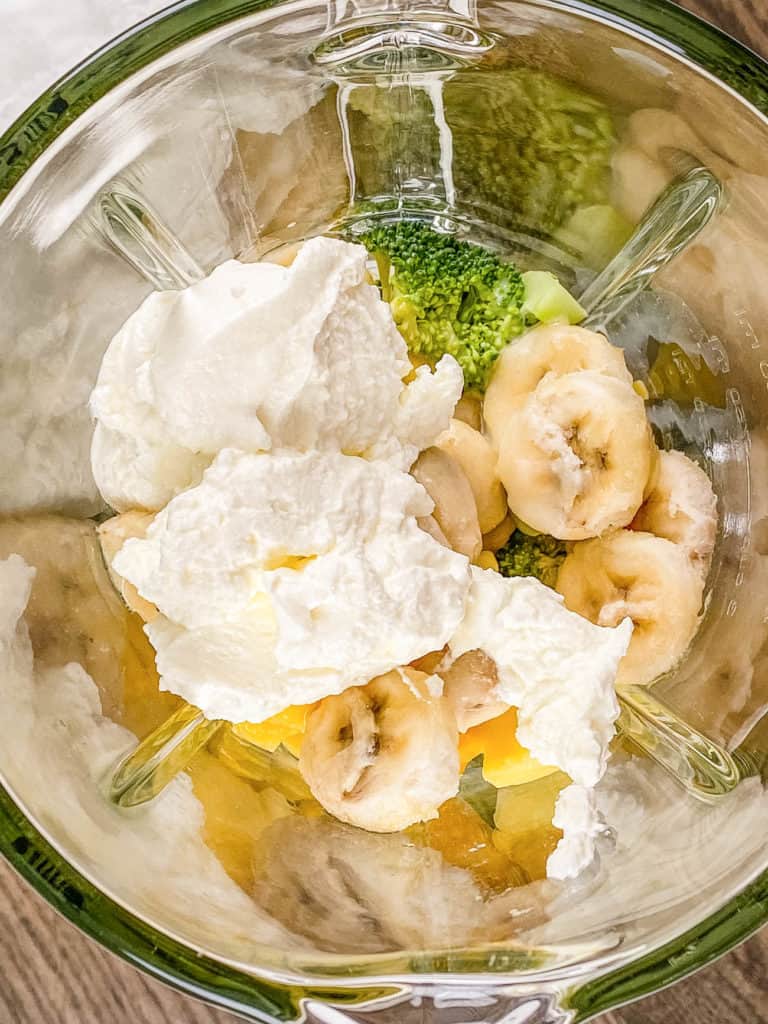
Serve: I enjoy my smoothie immediately!
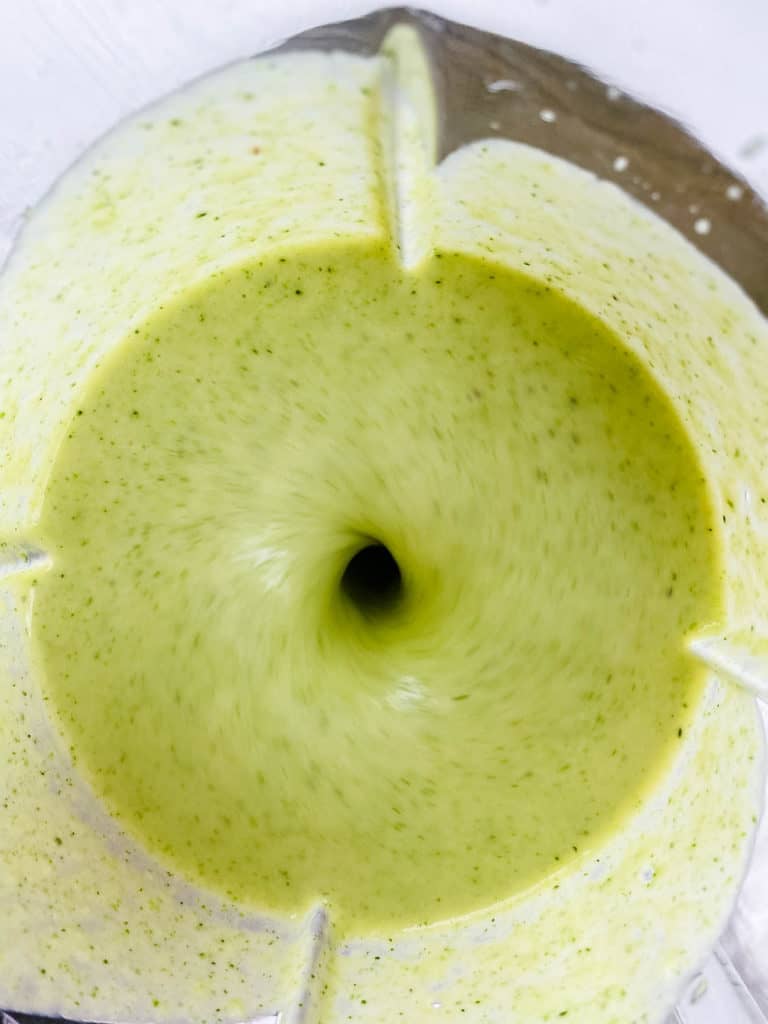
My #1 Secret Tip when making this smoothie is to use a high-speed blender. This is crucial for achieving a smooth, creamy texture without any remaining chunks of broccoli.
High-speed blenders (like a Vitamix) can fully pulverize the vegetables and fruits, ensuring that all the ingredients are well-blended. When you’ve got an ingredient like broccoli which is pretty fibrous, you really want to makes sure it gets completely blended in. This not only improves the texture but also enhances the flavor.
Other Tips To Keep In Mind:
- Add Liquid First: Pour your liquid (almond milk or any other milk) into the blender first to prevent ingredients from sticking to the blades. This helps create the smoothest consistency and saves me some blending time.
- Freeze The Banana: I like to freeze my banana ahead of time to create a thick and creamy smoothie that is already chilled and doesn’t need any ice.
- No Extra Sugar Needed: Thanks to the fresh fruit, you most likely won’t need to add sugar or coconut sugar (or any sweetener) to my recipe! I recommend tasting the smoothie before adding more sugar.
- Serve Immediately: For the best taste and texture, I serve this broccoli and banana smoothie right after blending before it begins to separate. If you do have to wait to serve, give it a good stir until fully combined again.
- Prep Ahead: For busy mornings, you can prep the ingredients the night before. I measure out the broccoli, mango, and banana and store them in the freezer. Then, in the morning, I just add the liquid and blend!
📖 Variations
Vegan: To make this banana broccoli smoothie vegan I use unsweetened coconut yogurt in place of the Greek yogurt. Any type of vegan yogurt will work; just keep in mind that thinner yogurt will produce a thinner consistency, so you may want to add a little less.
Mix-Ins: Make my already healthy broccoli and fruit smoothie even more nutritious by mixing in some omega-3 fatty acids like chia seeds, hemp hearts, flax seeds, or even nuts and nut butter.
Other Fruits: You can also change up the fruits. Instead of mango and banana, feel free to use other fruits like pears, apples, dates, and berries. Both fresh and frozen fruit work, but I do recommend freezing the fruit before making your smoothie.
Kid-Friendly Version: If your kids are sensitive to the taste of broccoli, try adding a bit more fruit to mask the flavor instead of adding sweeteners or sugar. This makes a great broccoli smoothie for toddlers.
Raw Broccoli Spinach Smoothie: If you want to add even more greens make a raw broccoli smoothie with a handful of spinach. Any leafy greens can be added. I love tossing in whatever greens happen to be in my fridge.
Additional Protein: To turn my recipe into a broccoli protein shake by adding a scoop of your favorite regular or vegan protein powder or 1 tablespoon of peanut butter or almond butter.
Broccoli Pineapple Smoothie: Instead of the mango, add ½ to ¾ cup chopped pineapple to make a broccoli banana smoothie with pineapple! My kids love this version.
Broccoli Milkshake: To make it even creamier and almost like a dessert, use some regular or vegan vanilla ice cream in place of the Greek yogurt.
Smoothie Bowl: Turn this into a smoothie bowl recipe! Pour the blended smoothie into a bowl and then top it with some of my healthy low calorie granola, nuts, and coconut. You can add any toppings you like.
🍽 Serving Suggestions
My broccoli mango smoothie with banana is delicious alone but it’s also a great accompaniment to a bigger breakfast, healthy snack, or lunch. These are just a few of my favorites.
With Breakfast: Enjoy it alongside a bowl of my cornmeal porridge or high protein overnight oats. Another great option is to pair it with my gluten-free chocolate chip banana muffins, blueberry sourdough muffins, or healthy bran muffins for a quick and easy on-the-go breakfast.
With Snacks: You can also enjoy your smoothie with snacks like my air fryer banana chips, healthy flapjacks, or no bake peanut butter bliss balls. It’s also perfect with some fresh veggies and my no garlic hummus or a piece of honey avocado toast.
With Lunch: For lunch, pair your smoothie with my vegan hummus avocado wrap or kale and caramelized onion veggie panini.
🧊 Storage Directions
Fridge: Smoothies are best enjoyed fresh, but if I have any leftovers, I pour them into an airtight container and store them in the fridge. They will stay fresh for about 24 hours. Before enjoying it again, I give it a good stir.
Freezer: Freezing will change the texture and possibly the taste, but smoothies will keep for up to 3 months when frozen. What I do is pour the smoothie into a freezer-safe container or ice cube trays. Once frozen, I put the frozen smoothie cubes in a ziplock bag. When ready to enjoy, I toss the ice cubes into my blender and puree.
❓Recipe FAQs
Yes! I often use pre-frozen broccoli, which is cheaper and sometimes even more nutritious than fresh broccoli, since it’s flash frozen right when it’s harvested. And the smoothie tastes just like if I had made it with fresh broccoli!
If you don’t drink your smoothie right after blending, it can begin to separate when the ingredients start to settle. This is natural and happens because different ingredients have different densities. To fix this, I simply give the smoothie a good stir or shake before drinking.
Broccoli smoothies can become bitter if it contains too much raw broccoli or if the fruit used is not ripe enough. If this happens, I balance the bitterness by adding a bit more sweet fruit or a little bit of a natural sweetener like honey or maple syrup.
Smoothies can sometimes curdle when acidic fruits (like citrus or pineapple) are mixed with dairy products (like milk or yogurt) and then aren’t served immediately. To prevent this, I use non-dairy alternatives such as almond milk or coconut yogurt when blending with acidic fruits. If curdling happens, it’s best to blend the smoothie again to try and recombine the ingredients.
No, in fact, I don’t recommend cooking any vegetables before adding them to smoothies because cooking veggies releases more of their water content and changes their texture, which will make your smoothie too watery and runny.
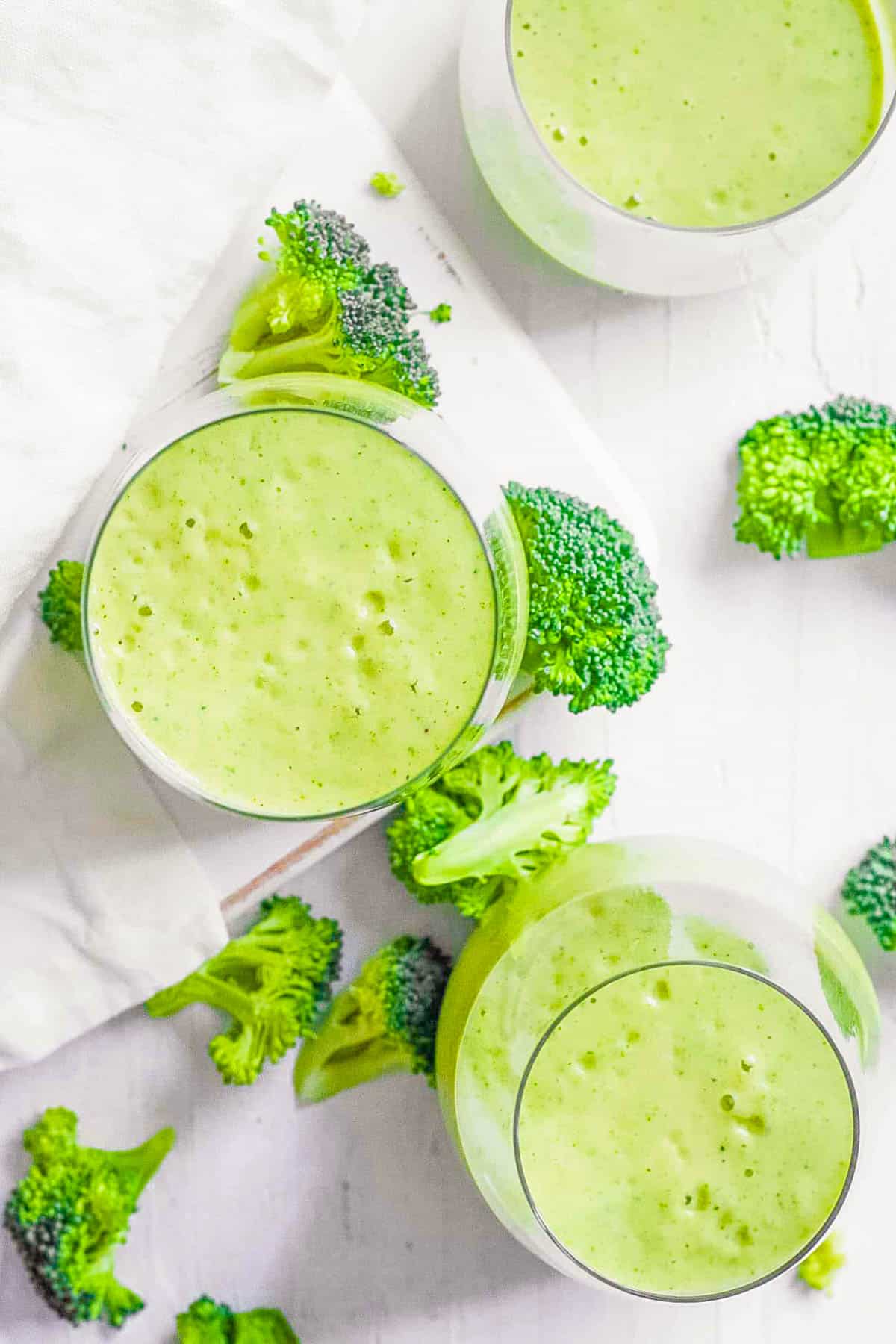
Looking for more smoothies with vegetables you can’t taste? Try some of my other delicious vegetarian smoothies!
Want to Save This Recipe?
Enter your email & I’ll send it to your inbox. Plus, get great new recipes from me every week!
By submitting this form, you consent to receive emails from The Picky Eater.
Love this vegetarian smoothie recipe? Please leave a 5-star rating 🌟 in the recipe below and/or a review in the comment section further down the page!
You can also FOLLOW ME on FACEBOOK, INSTAGRAM, and PINTEREST to see more delicious, healthy, family-friendly food, and if you have any questions, I’m here to help!
📋 Recipe Card
Easy Broccoli Smoothie
Packed with hidden veggies and sweetened with banana and mango, my rich and creamy broccoli smoothie is the perfect nutritious and delicious way to kickstart your day! Made with just a handful of basic ingredients, it takes just 5 minutes to make, and it also happens to be super kid-friendly too!
Servings: 2 servings
Calories: 173kcal
- Make sure the banana slices are frozen so the smoothie is thick, creamy, and smooth.
- Always adjust the sweetness to suit individual tastes.
- Maple syrup can be used as a substitute for coconut sugar.
- Using a high-speed blender will result in a very smooth and fluffy smoothie.
- To make this vegan, use unsweetened, plain coconut yogurt instead of Greek yogurt.
- Nutritional information includes coconut sugar.
Serving: 1smoothie | Calories: 173kcal | Carbohydrates: 30g | Protein: 9g | Fat: 3g | Saturated Fat: 1g | Polyunsaturated Fat: 1g | Monounsaturated Fat: 1g | Cholesterol: 3mg | Sodium: 165mg | Potassium: 462mg | Fiber: 4g | Sugar: 20g
-

 African History5 years ago
African History5 years agoA Closer Look: Afro-Mexicans 🇲🇽
-

 African History7 months ago
African History7 months agoBlack History Facts I had to Learn on My Own pt.6 📜
-

 African History5 years ago
African History5 years agoA Closer Look: Afro-Mexicans 🇲🇽
-

 African History1 year ago
African History1 year agoMajor African Tribes taken away during the Atlantic Slave Trade🌍 #slavetrade #africanamericanhistory
-

 African History1 year ago
African History1 year agoCameroon 🇨🇲 World Cup History (1962-2022) #football #realmadrid #shorts
-

 African History1 year ago
African History1 year agoWhat did Columbus Find in 1493? 🤯🔥🔥 #history #civilization #mesoamerica #africa #kemet
-

 African History7 months ago
African History7 months agoBlack History Inventors: Mary Kenner 🩸
-

 African History1 year ago
African History1 year agoOrigin Of ‘Cameroon’ 🇨🇲😳#africa


























